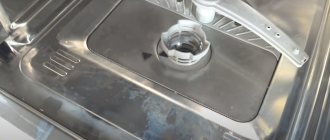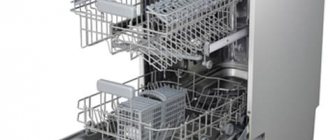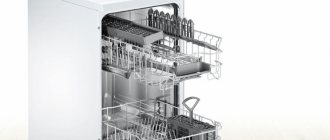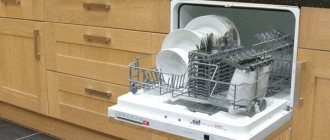Disassembling the dishwasher
It would be nice to understand how this technique washes dishes.
- Operating principle and device:
When the washing program is activated, the aquastop valve opens.
The stream of water begins to rotate the flow sensor, which registers the volume of incoming water.
Consists of a housing, a fan impeller with a permanent magnet and a printed circuit board with a reed switch. Water sets the fan impeller in motion. A magnet attached to the fan impeller drives the reed switch 2 times to the (North/South/North) position. The generated pulses are counted by the electronics of the control module.
Water entering the machine through a special tube squeezes out air in the pressure valve (pressure gauge).
Two microphones - one aquastop, the second water level sensor. Water is collected, the second sensor is triggered, the water continues to accumulate, the red float 3 raises, it turns on microphone 1.
The pump circulates the water in a circle, and the heater warms it up. A compartment with a tablet opens. The dishes are washed. The temperature sensor checks the water temperature - in accordance with the selected program.
1 – water softening system. 2 – foam float of the aquastop system 3 – drain (sewer) pump 4 – circulation pump 5 – “brains”, also known as the control board in the casing 6 – water supply valve to the machine.
- Protection device (emergency sensor):
At the end of washing, the drain valve opens and the water is drained using the drain pump. A new one is poured, warmed up and washed. Merges - similar to the first stage.
In the event of a leak, the machine is designed so that water always flows into the pan. There is a leakage sensor there - a foam float with contacts. If it floats up, the machine goes into emergency mode. Opens the drain valve and turns on the drain pump.
This is a hardware program - we stand and hum until it dries up. It may hum for two days, or until the pump dies from overheating.
- Disassembling the dishwasher:
The article describes an approximate lg diagram for informational purposes. The principle of operation is similar in Indesit Bosch Electrolux and Ariston. Be careful not to get water on the electronic components.
Before you start:
1.Unplug the cord from the electrical outlet to avoid electric shock. 2.Close the water tap. 3.Remove all dishes. 4.Remove the bottom shelf and top shelf. 5.Disconnect the fill hose and drain hose. 6.You will need a rag to collect any remaining water.
1.To remove the bottom cover, it is usually enough to unscrew two screws.
2. Front panel - unscrew several screws from the back of the door.
3.4.Control panel assembly:
– Remove the screws. – Remove the connecting wires. – Remember or take a photo of the order in which the connectors are connected so that you do not mix up the connectors during assembly. – Remove the lock assembly, display – Unscrew the 8 screws securing the control module.
5.Ventilation and drying system assembly
- Open the door. – Unscrew the door from the bracket. – Disconnect the connectors and wires. – Remove the air duct. – Turn the inner cover counterclockwise. – Remove the detergent dispenser.
6. Door springs (right and left)
– Pull the spring up and remove it from the bracket loop. Be careful not to injure yourself on the sharp edges of the tank! – Remove the spring from the loop. – Lift the door and remove it from its hinges.
7.8. Turn over and remove the bottom housing cover.
9.10. Unscrew the screws and remove the base and water intake valve.
11,12.Remove the tray holder and push the tray down, pressing the hooks to the side. Be careful not to drop the tray assembly. – Loosen the nut of the heating element and pull it out of the pan. – Unscrew the fixing screws and remove the drain pump.
- Disassembling a BOSCH dishwasher:
- Basic Troubleshooting
How to install a built-in dishwasher: step-by-step instructions
The equipment must match the furniture in size. Manufacturers produce their products according to the standards necessary to ensure that the equipment fits perfectly into a set or wall. Of course, standards vary, but there are not many options. Selecting a standard option is not difficult. To do this, just take measurements using a tape measure. You need to measure the width, depth and height of the niche or the space between adjacent sidewalls if the top of the household appliance will serve as the countertop. Connecting to the pipeline and sewerage should also not be a problem. This is no more difficult to do than installing a sink faucet. However, situations arise when it is not entirely clear how to integrate a dishwasher into a finished kitchen. Situations can be standard and non-standard. Let's consider what options there may be.
Where to begin
The main difficulty is that during installation the wizard is significantly limited in the workspace. Therefore, if possible, it is recommended to remove the countertop before installing the dishwasher. If this cannot be done, then the main rule during installation is not to break the sequence of actions and strictly follow the instructions.
Installing a dishwasher with the countertop removed
Experts recommend starting the installation process by preparing the mounting holes into which hoses for supplying and draining water will be routed, as well as the wires necessary to connect the dishwasher to the electrical network.
Detailed information about the sizes of dishwashers can be found in the following material.
At the next stage, anti-vibration pads are installed, which can be attached either to an adhesive base or using various hardware. At the next stage, the hoses and electrical cord are routed through the holes made, and the hoses are immediately connected to the water supply and sewerage system.
Reconciling the dimensions of the niche and dishwasher
After this, the dishwasher can be installed in a niche under the countertop. It is necessary to take into account that the height of the dishwasher should not exceed the distance from the floor to the bottom edge of the countertop. If this is not the case, it will not be possible to install a dishwasher, but there are exceptions to all rules, and some manufacturers offer universal models that can be built in or stand alone. Moreover, in order to embed such a model under the countertop above it, some manipulations are required. So, in most cases it is necessary to remove the top decorative cover, and to do this you only need to unscrew a few fasteners. As a result, the machine will be ready for installation under the countertop.
Choosing a location for installation
First of all, it is necessary to determine where the unit will stand. The closer it is to the pipes with hot and cold water, the less communications will have to be pulled. Proximity to a sewer pipe is equally important. The closer the drain, the greater the angle of inclination of the drain pipe. If it is located at a distance of several meters, the length of the flexible wiring may simply not be enough, and waste water containing food waste will stagnate inside in sagging areas.
In such situations, hard plastic or metal pipes are usually used, which makes installation more expensive, but this is the only way to avoid sagging. If the distance is large and the entrance to the sewer is located high, the technician will have to be raised on a pedestal to increase the angle of inclination of the drain pipe. All these troubles can be avoided by placing it near the sink.
Any equipment does not tolerate high temperatures well, so it is better to place it away from the radiator, stove and oven. Proximity to other household appliances is not desirable, but not dangerous either. Electromagnetic fields and static electricity will not cause serious harm to the motor and pump, but their operating life will be slightly shortened.
Electrolux dishwasher
When choosing a location, it is important to consider the location of the outlets and the length of the wire. As a rule, it is 1.5 m. It is prohibited to connect equipment using an extension cord, and installing a new outlet is long and difficult. To do this, you will have to move the wall and pull the wire.
The plug must not be closed tightly. It should always be in plain sight so that if it catches fire, it can be pulled out immediately. Failure to comply with this condition may result in a fire.
Preparation
Communications for connection
The machine requires three external sources to operate:
- electricity - must come from the electrical network of the house to the outlet closest to the car;
- clean cold water - there should be a water pipe nearby with a threaded connection;
- Sewage system - to drain dirty water, there must be sewer pipes nearby with the possibility of connecting an additional drain point.
Choosing a place
When deciding how to install a dishwasher, it is necessary to comply with the main installation condition - ensuring free access to all communications. In this case, the electrical outlet, water pipe (preferably with a faucet for connection) and the sewer drain pipe should be located as close to the machine as possible. In almost every kitchen, this condition is satisfied by a place in the cabinet near the sink.
Conduct the communications necessary for functioning in advance
Kitchen cabinet remodel
There are two options here - a free-standing cabinet or built into a common kitchen countertop. Before installing a dishwasher, let's assume that the dishwasher exactly fits the width and height of the cabinet, so alterations should be minimal.
Example of a cabinet with dishwasher and front panel
It is necessary to dismantle the bottom shelf, the front plinth and then remove the doors. Only the back panel, the tabletop at the top and the side walls of the cabinet remain, which makes this design very unstable.
All dishwashers are designed to be attached to the countertop and side walls, but this varies depending on the manufacturer. If in Electrolux brands the attachment to the side walls occurs at two points (on both sides of the machine in the upper corner under the tabletop), then in Bosch there are four attachment points.
The type of mounting depends on the features of the cabinet for your machine.
The machine is attached to the side walls of the cabinet through four plastic inserts on both sides at the top and bottom of its body, which makes the structure stable and durable.
Dimensions for built-in dishwasher
You can select the dimensions before purchasing on the website of the store or manufacturer. They must be a multiple of the height and width of the tabletop, as well as all the parameters of a niche or cabinet if the equipment needs to be hidden behind the door. Instead of a regular door, a decorative damper is often used, designed in the same way as the entire facade.
There are several standard solutions. The standard depth is 0.55 m. This leaves enough space of just under 50 cm for water supply and air cooling. For kitchen sets designed for standard apartments, narrow models with a width of 0.45 m are produced. It can vary up to 0.65 m. Most often it is 0.6 m. The height ranges from 0.815 to 0.875 m. It is a multiple of the height of ordinary countertops
There are dishwashers with minimal dimensions for installation. They are installed not only under the countertop. They are even located in the upper modules. The upper cabinets are narrower, and their depth is on average 15 cm less. In this case, problems with drainage should not arise even at a considerable distance from the siphon. You will only need to hide the drain pipe, connect the device to the water supply and resolve the electrical issue. Such devices have low productivity, but they are compact and consume less water and electricity.
Kitchen furniture manufacturers make a small margin by adding 2 mm on each side inside the modules. On the contrary, the built-in equipment is slightly smaller than the declared dimensions. This is necessary so that it fits into the niche prepared for it, even taking into account small irregularities.
The dimensions of the built-in dishwasher are one of the most important selection criteria. If it does not fit in size, it is better to refrain from purchasing and continue searching.
Equipment options and recommendations for dishwasher placement
To choose the best option for household appliances, you must know what types they come in. In addition, you need to determine in advance where the machine will be located, since both its size and installation options depend on this.
Types of equipment
There are four main options for this technique:
- Built-in dishwasher . Completely hidden behind the facade of the kitchen and not visible from the outside. This is the most inexpensive option, the appearance of which, in fact, is not important, the main thing in this case is the size, they should ideally fit the space that is available;
A furniture facade is attached to the front cover of the built-in appliances
- Equipment with an external control system . These options have all the adjustment elements and buttons located on the outside. This provides ease of use, but significantly complicates the installation process, because the panel is attached to the furniture façade and connected separately. It is better to entrust the installation of this option to specialists to avoid problems;
The external control system is convenient, but complicates the installation process
- Open systems . This option differs from the previous ones in that the front part of the structure is not covered by anything and is visible from the outside. Accordingly, the facade is made attractive and matches the overall design of the kitchen. The price of this group of products is the highest, but it is easier to install them, because the structure is located on the floor and does not need to be covered with decorative elements;
Open options can be compact in size for placement in small kitchens
- Desktop option . If you don’t know where to put a full-size machine in a small kitchen, then a desktop modification can be an excellent solution. It takes up minimal space and is very easy to install. The main thing is that there is an outlet and a drainage system.
This is the most compact equipment option
Recommendations for system location
To decide where to install your dishwasher, consider a few important tips:
If you have to place household appliances on the edge, then attach a sheet of chipboard to the wall to securely fasten on both sides.
The length of the drain hose should be no more than 150 cm. Otherwise, the load on the pump will be very high, and it will work much less than it could with a short drain length.
How to integrate a dishwasher into a finished kitchen - options and work order
Published by Artyom on 03/12/2019 03/12/2019
Many housewives choose a dishwasher not only for saving time on daily housework, but also for saving water. If repairs are not planned in the near future, then you can install the equipment directly into the headset. Built-in appliances have a number of advantages: installation in a finished kitchen does not spoil the design idea, the device is hidden behind a piece of furniture, and even a man who does not have sufficient experience can handle the installation. To do this, you need to decide where to install the device, calculate the geometric parameters of the niche, and select the model of the device. With a long-awaited purchase, the question arises: how to integrate a dishwasher into a finished kitchen? This article will help you install the device so that the equipment works for a long time and without failures.
Choosing a location depending on the type
To install the device, you need to correctly determine the location of the equipment: the section opening must correspond to the dimensions of the machine box, the communication means are located nearby. Experts offer several options:
| Type of equipment | Dishwasher space | Advantages | Flaws |
| Partially built-in and fully built-in | Under the sink in the sink | The depth and width of many models are the same; proximity to sewer water communications | The bottom of the sink may need to be reworked; buying a new siphon |
| Base cabinet | The instrument panel is hidden behind a decorative facade | The need to remodel a piece of furniture | |
| Dismantling a niche in a kitchen set | Selecting a panel to match the color of the furniture facade | Reducing kitchen utensil storage space | |
| Compact models | For a free-standing household appliance | Easy installation | The need to consider access to communications; technology reduces space in the room |
Thus, compact models are easiest to fit into a finished kitchen.
Why remove the machine?
Indeed, why take the machine out of the built-in kitchen, for what purpose? It stood there for many years and may it continue to stand.
- The first and most obvious goal is to repair the machine. Many breakdowns can be eliminated by gaining access to the parts of the machine tray, and such access can only be obtained by dismantling the built-in dishwasher. There are no other options.
- The second goal is related to replacing the dishwasher unit. You can sell your old equipment to someone else, and use the proceeds to buy a new “home assistant.” But in order to sell an old machine, it must be removed correctly so as not to damage anything or completely ruin the presentation of the equipment.
Improper removal of the dishwasher may result in it being unable to be reinstalled.
- The third goal is more global - renovation of the entire kitchen with replacement of furniture. When disassembling a kitchen set, it is impossible to leave the machine in it. She needs to be pulled out, and this needs to be done carefully, since further use of the “home assistant” is planned in the future.
As you can see, there are more than enough reasons. If one of them affected you, read our post to the end and understand how to properly remove your dishwasher.
Additional work
If necessary, holes are drilled in the cabinet walls for drain and water supply hoses and a power cord.
Installation of the “facade”
To match the design, interior and color of the kitchen, the front side of the doors of all built-in dishwashers is covered with a pre-ordered panel of the required size. To attach it to the car door, the delivery kit includes special fasteners and a template.
Making a custom front panel is not that difficult, but the interior of the room will look neat
The necessary drawings are drawn on a large sheet of paper and the points for attaching parts to the decorative panel are marked, the sheet is applied to it and, using a sharp awl, the points are transferred to the panel, after which the fasteners and door handle are screwed into the marked places with self-tapping screws. Then the panel is fixed to the car doors and screwed to it with self-tapping screws through the holes around the perimeter of the doors.
Tabletop protection
Before installing a dishwasher under the countertop, you need to pay attention to the following. All dishwashers have a not very good design feature - when the doors are opened, steam and moisture from the machine rise up and fall on the lower surface of the countertop, spoiling it.
Some manufacturers create protection against steam and moisture
If the kit does not provide special protection for the tabletop, you should take care of this yourself. You can use special tape, plastic, metal, etc. for protection.
In Bosch models, a special metal plate is attached under the tabletop before installing the machine; in Electrolux, a film made of a special material is glued.
Adjusting the required height
The final installation consists of adjusting the machine to the tabletop using the front and rear legs and leveling it. Then the necessary gaskets are inserted between the side walls of the cabinet and the machine and the walls are attached to each other. The dismantled lower decorative panel, if necessary, is cut off and put in place.
The rules for installing dishwashers require a gap between the rear wall of the machine and the kitchen wall to be at least 50 mm.
Any owner who wants to save money can install a dishwasher into a finished kitchen; it is not necessary to call highly qualified specialists. You can learn how to carry out the work correctly and avoid annoying mistakes from this article.
How to remove a dishwasher from a built-in kitchen
The built-in dishwasher has become so commonplace that many owners perceive it as a piece of furniture, but this is a technique that may one day require attention.
You will have to decide how to remove the dishwasher from the kitchen, and this is not as easy as it might seem at first glance.
If you act skillfully, you can remove the machine in a few minutes and we intend, within the framework of the article, to explain in detail how this is done.
How to install a 45 cm and 60 cm dishwasher with your own hands
You can install the dishwasher yourself. There's nothing complicated about it. But if this is your first time encountering this, then you better be well prepared before the box with the unit is brought home to you.
You must understand where and how you will do the installation. What knowledge and skills will you need for this? What tools will you need? What problems might you encounter? What you need to do to ensure that the dishwasher you bought and installed yourself worked for a long time and reliably.
Preparing the kitchen for a dishwasher
Start preparing by choosing a place in the kitchen. The size of the section opening must correspond to the width of the machine box. For example, a built-in dishwasher 45 centimeters wide should fit freely into the opening you choose and not leave very large gaps. Here you may be faced with two options:
- Installation in a new kitchen.
- Installation in an old kitchen.
If the furniture in your kitchen is new and modern, then you should not have problems with installation. All modern kitchen cabinets and cavities are standardized and require built-in kitchen appliances. To integrate a dishwasher, you don't have to modify anything.
And if you bought furniture for the kitchen a long time ago, then you may not have suitable ready-made options for installation. So get ready to do a little work with a tape measure, hammer, hacksaw and other tools.
Keep in mind that the most common built-in dishwashers on sale are 45 cm and 60 cm wide. Their height may be different. But all of them are equipped with sliding legs.
Recommendations for correct installation
Very useful information on how to install a dishwasher can be found in the rules and recommendations from the manufacturers. For example, a Bosch built-in dishwasher (45 cm wide) comes with a whole package of necessary instructions.
Before you begin the installation yourself, find all the information available. Watch a couple of videos on how to install and connect. You must do everything correctly and competently.
Some useful nuances:
- Grounding must be done. This is a mandatory norm.
- The length of the drain hose should not be more than 1.5 meters. Otherwise, the injection pump can quickly fail as a result of increased load.
- Do not install a dishwasher under a hob.
- Be sure to install a protective metal plate under the countertop. It will protect it from hot steam and protect it from swelling and deformation.
Remember, a mistake can cost you dearly. It will be unpleasant to flood your neighbors with water or receive a slight electric shock if there is no properly grounded connection. Be careful.
Dishwasher installation conditions
Before purchasing and installing a dishwasher, you need to find a suitable place for it.
The easiest way is with free-standing units - even a piece of free space on the floor or table is enough for them. But what to do when you plan to buy a built-in model that can be hidden behind a decorative panel?
The main advantage of built-in kitchen equipment is its “invisibility”. Powerful, multifunctional units are hidden behind furniture facades, without overloading the interior with their technicality
You need to arm yourself with a construction tape and check which cabinets are suitable for installing a PMM. Finding out the sizes of dishwashers is easy - information is posted on the official websites of stores that sell household appliances.
When making machines, manufacturers are guided by human height and furniture sizes, and accordingly adapt their models to uniform standards.
For example, most dishwashers from well-known brands have a width of 60 cm (more precisely, 598 mm) or 45 cm (448 mm). 45-centimeter models are called narrow, and they have more options for embedding in a finished kitchen.
Functionally and in terms of the number of programs, narrow dishwashers are not inferior to wide machines, so sometimes it makes sense to analyze the offers of this type of equipment
Narrow models, as a rule, have a height from 815 mm to 875 mm , which is equal to the standard height of kitchen tables and cabinets.
If the set is made to order, the level of the countertops may be lowered for technical reasons, for example, a pipe is in the way, etc. Therefore, accuracy is needed when measuring - just one extra centimeter can be decisive.
Machine depth – 550 mm . During installation, a few centimeters remain for comfortable connection of hoses and wires so that they are not pinched.
Average dimensions of a compact machine: 550x500x438 (WxDxH). Unlike a free-standing model, a built-in model requires a furniture module that is suitable in size
If you have found a cabinet that is suitable in size, do not forget to take into account the location of communications:
- cold water pipes;
- sewer pipe;
- free power line with socket.
An additional electrical cable can be laid if necessary, but it is hardly possible to move the pipes in a ready-made kitchen, so the installation location of the machine is usually chosen next to the sink - this is where the main water supply and drainage units are located .
If at least one of the conditions is not met, for example, there is no suitable module or there is no access to communications, then you will have to postpone the purchase of a built-in dishwasher or think about remodeling the kitchen.
Possible embedding options
A cabinet for embedding a PMM may look different. We suggest considering several popular options that are convenient for installation.
Each type of installation is associated with difficulties. To minimize them, it is important to comply with the above conditions and requirements specified by the manufacturer in the instructions. We offer several recommendations for installing a dishwasher in different places.
Solution #1 - built into a closet
If there is a cupboard with a width of more than 45 cm next to the sink, then it can be used to install a dishwasher.
The advantage of installation close to communications is the ability to integrate machine hoses into an already installed system under the sink.
Dishwasher connection option: extended cold water supply pipe with shut-off valve, drain hose outlet into the washing siphon, separate electrical outlet
You will have to remove the shelves and back wall from the cabinet, and, if necessary, the bottom panel. The built-in housing must be brought into a strictly vertical position; for this, adjustable legs are used.
Then you need to alternately connect the machine to the sewerage system, water supply and power supply. If necessary, an additional water seal with a drain pipe should be installed.
The decorative front panel, which is attached to the machine door, is usually assembled from removed cabinet doors or ordered additionally. Partially built-in models do not need to be decorated, so their installation is a little easier.
Solution #2 - installation in a separate module
If there are no free cabinets for new equipment, but there is enough space in the kitchen, you can order a separate module, but you need to install it near communications.
A cabinet for additionally purchased equipment – a compact washing machine and dishwasher. The module is installed as close as possible to the sink, which facilitates connection
It is important to level and secure the unit so that it does not vibrate during operation or move the cabinet . Hoses and pipes are laid along the wall, but they are easier to access.
To get to the communications, you don’t have to dismantle the car, but simply move the cabinet away from the wall.
When the dishwasher is installed under a common kitchen countertop, it has to be removed for maintenance, since otherwise the hose connections cannot be reached.
Solution #3 - installation in a niche
If the kitchen has a niche for installing a microwave, oven or other small equipment, it can also be used to install a dishwasher.
Dimensions of the compact model along with drawings can be found in the installation instructions.
If the niche is located far from communications, you will have to stock up on long flexible hoses to supply cold water and drain used water
Built-in compact models should not be confused with free-standing ones. The latter do not have to be placed in a niche - any horizontal surface is suitable for their installation.
So that the dishwasher is not conspicuous and is hidden like the rest of the equipment, the front part is covered with a decorative overlay in the style of a facade.
Developers usually think through various options for installing equipment, so the installation instructions include drawings and diagrams with dimensions, useful tips, and technical recommendations.
It’s easier to find a place for a compact model, but don’t forget that a mini-machine is not able to serve a large family.
Solution #4 - if embedding is not suitable
What to do if there is absolutely no space in the kitchen to install a built-in model? It remains to consider free-standing options, the design of which does not require special installation.
They can simply be installed on the floor, countertop or niche, leveled, and then connected.
There is another way to fulfill your own dream of installing a built-in dishwasher - a complete reconstruction of the kitchen unit, with possible repairs or relocation of communications.
It is more expensive and requires not only financial investments, but also time.
Installation procedure for the built-in model
The dishwasher installation algorithm is described in the instructions provided by the manufacturer. Usually it consists of several stages, the first of which is preparatory.
Basic components for embedding
Below is an approximate list of what you will need for work:
- A set of tools (pliers, Phillips screwdriver, drill, self-tapping screws, building level).
- To connect the pressure water hose you will need a brass water tee.
- Material for sealing (tow, rubber fum tape, gaskets).
- Ball valve.
- Siphon if the appliance is installed in a sink.
- Clamps, crimp couplings
Important! To install a separate outlet, you will need a two-core copper wire with good insulation. Choose a moisture-resistant outlet.
How to install a dishwasher: tools and parts
Prepare everything you need so that the tools are at hand. You will need:
- a set of slotted and Phillips screwdrivers;
- wrench;
- pliers;
- drill with a set of attachments;
- wire cutters;
- level;
- chisel;
- roulette.
- siphon;
- Euro socket;
- ball valve;
- brass tee;
Electrical connection
If you do not have a special outlet organized, we recommend calling a specialist for installation. He will cut a channel in the wall and lay a three-core copper wire, install a difavtomat and connect a moisture-resistant socket through it.
Now you are ready to proceed further.
Connection to water supply
Connect your dishwasher to a cold water source as it is of better quality. Moreover, the equipment is equipped with a heating element, which independently heats the water.
Read the instructions carefully. It is possible that only cold water is allowed to connect your model, and if you connect to hot water, you may lose your warranty.
We recommend additionally installing a coarse filter. It will provide protection from large debris, soften the water, so scale will not settle on the heater.
- Place a tee on the end of the cold water pipe;
- Connect the inlet hose to one outlet and the mixer to the other.
If your tee does not have a shut-off valve, install one immediately.
Wrap the joints with fum tape. It seals all connections.
Sewage work
First of all, a siphon with two drainage holes is installed. One will be used to connect a dishwasher, the other - a washing machine. You can also replace the sink with a more compact option.
- Place the drain hose 60 cm from the floor. Secure it with clamps to the furniture.
- Before connecting the end of the hose to the siphon, bend it so that the water from the machine goes into the siphon.
Is the hose not long enough? Don’t rush into extensions; it’s better to buy a new element of the required length. This way you will avoid the risk of a flood.
Now you know how to do all the work yourself. All that remains is to place the equipment in place. How to do it right:
- Move the PMM closer to the cabinet (you can immediately install it in the cabinet, if that’s more convenient).
- Connect the drain hose to the siphon.
- Reconnect the intake hose.
- Slide the dishwasher under the countertop.
- Use bolts to install the front part.
The work is completed. All that remains is to conduct a test run to check the correct connection. A video on the topic will help you:
How to dismantle
To remove the dishwasher from the built-in kitchen, you need to perform the following steps:
- prepare screwdrivers with different attachments;
- unplug the power cable from the socket and turn off the water supply tap;
- remove the narrow front panel, which is installed under the car door (if there is no decorative strip, this step is skipped);
- disconnect the inlet hose, first placing a container to collect the remaining water;
- disconnect the drain pipe from the siphon fitting by cutting or loosening the clamp in advance;
- open the car door, find the fasteners coming out and unscrew them (these bolts secure the device body in the niche);
- reduce the height of the legs to the limit;
- holding the body with 2 hands, move it forward with rocking movements (you must make sure that the machine does not fall).
This completes the dismantling. Some appliances have fronts that also need to be removed.
Why is it better to get a built-in dishwasher yourself?
Many users of Bosch, Siemens, Electrolux and other brands of dishwashers are thinking about how to remove the machine from the built-in kitchen. If everything is done correctly, the work will not take more than 10 minutes.
Why is it better to do the work yourself rather than contact a service center? You can save on the work of a master, who will definitely count the dismantling of the PMM as a separate service.
For example, equipment needs diagnostics to find out the cause of the breakdown. What you pay for:
- for a specialist visiting your home (depending on the company);
- for diagnostic services;
- It will be on the spot: in order to carry out the inspection, you need to remove the PMM from the furniture - you will also pay for this.
Whether to contact the service center or not is up to you. After reading our article, you will learn how easy it is to do the work yourself.
After purchasing a dishwasher, many turn to furniture makers who install and connect the appliances. There are cases when self-tapping screws are used to drill through furniture panels or the body for better fastening.
As a result, the plastic water tank located at the side wall of the PMM is damaged. There may not be any immediate leakage because the self-tapping screw is inserted tightly. But when you decide to pull the car out, the tank will no longer be restored.
How to install and connect a dishwasher, read the previous article.
Recommendations
To ensure that the built-in machine works for a long time and does not flood your neighbors, listen to some tips in advance:
- check for grounding - this will prevent electric shock;
- make sure that the drain hose is no longer than 2.5 m - increased load negatively affects the operation of the injection pump;
- It is not recommended to install the device under the hob;
- To protect the countertop from steam, think about protection; a metal plate is perfect for this purpose.
Now you have an idea of how to integrate a dishwasher into your kitchen. To install equipment in a ready-made kitchen set, you will need not only ideas on where to install the device, but also skills in working with plumbing and plumbing tools.
Number of blocks: 7 | Total number of characters: 8011 Number of donors used: 3 Information on each donor:
How to organize the process
First you need to remove the cabinet; to do this, you need to unscrew the screws that connect it to the rest of the set. Once there is nothing in the way, pull the furniture towards you. Next you should do the following:
- Disassemble the cabinet, separating the back part, as it will interfere with the installation of hoses and wires. The part of the plinth that is located in front is also being removed for now. The rest of the structure should be placed back and secured using self-tapping screws to the side cabinets.
- To connect the hoses, as well as for the socket, you need to drill additional holes in the headset.
- Place a metal film on the countertop to protect against steam.











